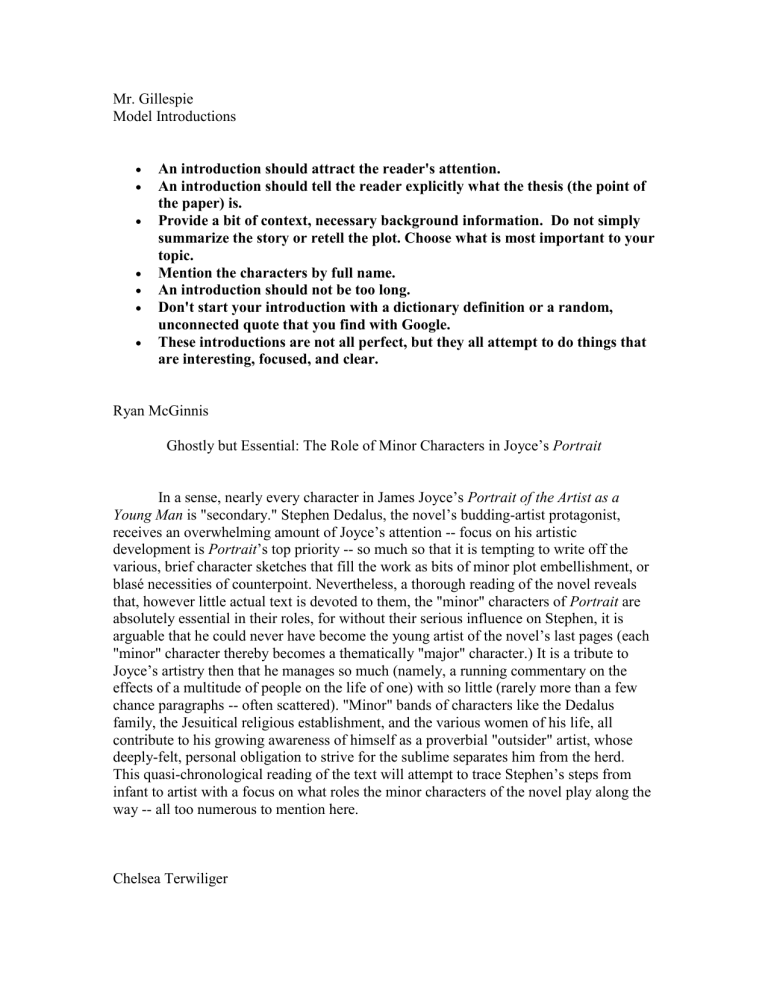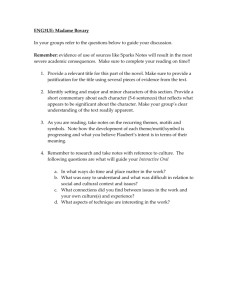Mr. Gillespie Model Introductions An introduction should attract the reader's attention.

Mr. Gillespie
Model Introductions
An introduction should attract the reader's attention.
An introduction should tell the reader explicitly what the thesis (the point of the paper) is.
Provide a bit of context, necessary background information. Do not simply summarize the story or retell the plot. Choose what is most important to your topic.
Mention the characters by full name.
An introduction should not be too long.
Don't start your introduction with a dictionary definition or a random, unconnected quote that you find with Google.
These introductions are not all perfect, but they all attempt to do things that are interesting, focused, and clear.
Ryan McGinnis
Ghostly but Essential: The Role of Minor Characters in Joyce’s Portrait
In a sense, nearly every character in James Joyce’s Portrait of the Artist as a
Young Man is "secondary." Stephen Dedalus, the novel’s budding-artist protagonist, receives an overwhelming amount of Joyce’s attention -- focus on his artistic development is Portrait
’s top priority -- so much so that it is tempting to write off the various, brief character sketches that fill the work as bits of minor plot embellishment, or blasé necessities of counterpoint. Nevertheless, a thorough reading of the novel reveals that, however little actual text is devoted to them, the "minor" characters of Portrait are absolutely essential in their roles, for without their serious influence on Stephen, it is arguable that he could never have become the young artist of the novel’s last pages (each
"minor" character thereby becomes a thematically "major" character.) It is a tribute to
Joyce’s artistry then that he manages so much (namely, a running commentary on the effects of a multitude of people on the life of one) with so little (rarely more than a few chance paragraphs -- often scattered). "Minor" bands of characters like the Dedalus family, the Jesuitical religious establishment, and the various women of his life, all contribute to his growing awareness of himself as a proverbial "outsider" artist, whose deeply-felt, personal obligation to strive for the sublime separates him from the herd.
This quasi-chronological reading of the text will attempt to trace Stephen’s steps from infant to artist with a focus on what roles the minor characters of the novel play along the way -- all too numerous to mention here.
Chelsea Terwiliger
Beyond the Physical Loss: A Town's Suffering in The Sweet Hereafter
In Russell Banks' The Sweet Hereafter , fourteen children of the town of Sam Dent, New
York are lost in a tragic school bus accident, and the novel is told in four different perspectives to describe the grief and emotion felt throughout the town. The first to tell her story is the bus driver, Dolores Driscoll, who spends every morning with the students and is unharmed by the accident. Billy Ansel, a father who loses both of his children in the accident, copes with his pain by drinking to oblivion. The lawyer, Mitchell Stephens, an outsider from the city, inquires throughout town about suing the township for their role in the children's deaths. Nichole Burnell, a high school freshman, is crippled by the accident and it is her false testimony that causes the townspeople to drop all lawsuits before any more damage is done. The town of Sam Dent suffers a terrible misfortune, and in addition to the substantial loss of life, each of the four characters is plagued by grief unassociated with the physical depravation. Banks uses the different backgrounds and relationships of his characters to explore the true nature of guilt and blame as each suffers a loss that goes beyond physical pain.
Sanjay Misra
Examining Absurdity and the Value of Life in The Stranger
Numerous people struggle throughout their lives to find a redemptive meaning to existence in the face of inevitable death. French Algerian author Albert
Camus wrote several works promoting a philosophy known as absurdism, which states that "the work of each individual gives meaning inside a world otherwise meaningless"
(Heims 21), indicating his belief that humanity cannot find greater meaning in the universe but can still create value in life. In Camus's novel, The Stranger , the amoral protagonist, Meursault, faces and resolves this dilemma of accepting the absurd nature of life as he awaits his execution for murder. Meursault begins his story shortly after his mother's death by narrating several events in his life that depict him as a young man who is indifferent toward life and the world around him. One Sunday, while visiting a friend's beach house, Meursault shoots an Arab man he encounters for no apparent reason.
During his trial for homicide, the jury sentences Meursault to death by guillotine "not for his action [of murder], but for his attitude" of apathy towards his mother's death (Tarrow
2). Approaching his punishment, Meursault accepts the indifference of society and the certainty of death, yet he manages to reevaluate the significance of human life. By delineating Meursault's transformation from an apathetic man with only physical sensations into a conscious individual with real emotions, Camus reveals his absurdist perspective that humans should seek, and can find, value in life despite the lack of a
"higher meaning" in society and the universe.
Jessica Hwang
The Amber of Time: Free Will and Death in Kurt Vonnegut's Slaughterhouse-Five
"So it goes," laments the narrator after each death that occurs in
Kurt Vonnegut's Slaughterhouse-Five . Slaughterhouse-Five , an account of the firebombing of Dresden in 1945 and protagonist Billy Pilgrim's travels in time, is an antiwar novel written by Kurt Vonnegut, a veteran of World War II. The novel consists mainly of flashbacks, some from Pilgrim's journey as a prisoner of war and some from his imagined time travels and kidnapping by aliens called Tralfamadorians. The
Tralfamadorians see in four dimensions rather than three, meaning that they can see any object or person at any time in its existence. Time is a "constant condition" (Cox 2) that exists in every moment. This allows them to know exactly when and how the universe ends, something that they cannot stop. The Tralfamadorian philosophy is that there is no such thing as free will; "all moments... always have existed, always will exist" (Vonnegut
23) and everything is already fated to happen. Of all of the planets the aliens have visited, the only one with free will has been planet Earth. Throughout Vonnegut's novel, the author provides the reader with his opinion on free will-that it does not exist, and that everything in time has been arranged already. Death is just another phase in one's existence and is part of the natural cycle of the earth. Vonnegut shows his opinion on the lack of free will through the wisdom of the Tralfamadorians, Billy Pilgrim's experiences in World War II, and Pilgrim's view of death.
Linda Le
In Celie’s Own Voice: Alice Walker’s Use of Diary Entries as Characterization
A diary may record significant changes that occur throughout one's entire lifetime, telling the truths and details of all events which may culminate into a huge transformation. In The Color Purple , Alice Walker proves this idea by creating Celie, a black woman who was raped at fourteen years old by the man who raised her. Her diary contains informal language which emphasizes her lack of education due to her slavery to men. She struggles with inferiority in terms of her perceived social norms about being a weak woman. At first, while she suffers from inferiority, she experiences insecurity and attempts to see her abuse as acceptable. She copes with her problems by accepting them and only fighting merely to stay alive. Walker assigns specific names to different characters to reflect the personalities and importance or lack thereof of each individual in
Celie's life as she struggles with her own identity in her search for an explanation for all of the pain which she has had to go through. However, Celie soon finds role models in strong women such as Sofia and Shug who teach her about individualism. Walker uses the color purple in numerous ways throughout Celie's life as a symbol with changing definitions as Celie matures in her understanding of self and God. In Alice Walker's The
Color Purple , one gains a better understanding of Celie's life through diary entries and letters that reveal the crippling effects of her slavery through language, feelings of inferiority, insecurity, giving up a voice to stay alive, the importance of one's name and identity, learning from various role models, and the importance of the color purple in her
renewal. Eventually, Celie learns to rebel against norms, resulting in a renewal of character which increases her personal happiness.
Vivan las Mariposas:
In Julia Alvarez's In the Time of the Butterflies , the fictionalized story of true events involving the four Mirabal sisters, Dede, Minerva, Maria Teresa, and Patria, demonstrates the link of courage that binds family together through a common cause.
Engaged in political turmoil between 1938 and 1961 during the regime of the Dominican
Republic's dictator Rafael Trujillo, the Mirabal sisters, later to become known as "The
Butterflies" (310) or "Las Mariposas" (324), risk their lives for the betterment of their country. Returning from a visit to their husbands who are held as political prisoners,
Minerva, Maria Theresa, and Patria are ambushed and murdered on the way home, as ordered by Trujillo. The martyrdom of Minerva, Maria Teresa, and Patria is retold through the only surviving sister Dede. Although all the Butterflies are part of the same cause, each one has a different motivation for joining the underground movement opposing Trujillo, and each possesses her own unique personality: "Minerva...the rebel;
Mate, the follower; Patria, the saint; Ded[e], the vacillator" (Mujica 4). Though very different in character, each Mirabal woman finds her courage and is connected to her sisters through a shared purpose in fighting for a free country, and ultimately, it is this purpose which binds them together and their unfortunate fates.
Kristin Kitts
When Dreams Don't Come True:
Expectations and Realities in Gustave Flaubert's Madame Bovary
There comes with the naiveté of youth certain expectations of life that children, until they reach that age in which juvenile dreams give way to more realistic pursuits, carry with them in their hearts everywhere: to be loved, to get married, to become successful, and to live a well-furnished life. Some adjust their pursuits to be feasibly achievable, while others cling to those beliefs as though clinging to life itself. Emma
Bovary, the tragic heroine of Gustave Flaubert's Madame Bovary , falls into the ill-fated latter. The daughter of a farmer and his deceased wife, Emma spends her youth in a convent school, where she first "succumb[s] to the mystic languor" that opens the gates to her vivid imagination (Flaubert 34). From there, the novels provided by a visiting spinster are free to plant the Romanticism-inspired seeds that would, upon Emma's learning of
"love affairs, lovers, mistresses,...palpitating hearts, vows, sobs, tears and kisses..., and gentlemen brave as lions, gentle as lambs, virtuous as no one really is, and always ready to shed floods of tears," take root and grow into the intensely sexual, amorous expectations of life and love that she carries with her for the duration of the novel (36).
Unfortunately, as Robert Wooster Stallman notes, "The blueprint upon which Flaubert pins Emma...doom[s] her from the start" (7). After her marriage to Charles Bovary, the officier de sante of the town of Tostes, Emma finds her Romantic dreams unfulfilled and becomes discontent; she subsequently engages in a repeating pattern of failed affairs, banality, a desire to escape, and depression, resulting in her eventual suicide. Due to her longstanding belief in the possibility of attaining a refined, yet debauched, upper-class
lifestyle, Emma Bovary dooms herself to a life of disappointment, as any attempt to make her dreams real, ends in crushing reality, a reality which she is unable to handle due to her fantastical misconceptions of life.





